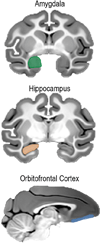The nature of individual differences in inhibited temperament and risk for psychiatric disease: A review and meta-analysis
- PMID: 25784645
- PMCID: PMC4516130
- DOI: 10.1016/j.pneurobio.2015.03.001
The nature of individual differences in inhibited temperament and risk for psychiatric disease: A review and meta-analysis
Abstract
What makes us different from one another? Why does one person jump out of airplanes for fun while another prefers to stay home and read? Why are some babies born with a predisposition to become anxious? Questions about individual differences in temperament have engaged the minds of scientists, psychologists, and philosophers for centuries. Recent technological advances in neuroimaging and genetics provide an unprecedented opportunity to answer these questions. Here we review the literature on the neurobiology of one of the most basic individual differences-the tendency to approach or avoid novelty. This trait, called inhibited temperament, is innate, heritable, and observed across species. Importantly, inhibited temperament also confers risk for psychiatric disease. Here, we provide a comprehensive review of inhibited temperament, including neuroimaging and genetic studies in human and non-human primates. We conducted a meta-analysis of neuroimaging findings in inhibited humans that points to alterations in a fronto-limbic-basal ganglia circuit; these findings provide the basis of a model of inhibited temperament neurocircuitry. Lesion and neuroimaging studies in non-human primate models of inhibited temperament highlight roles for the amygdala, hippocampus, orbitofrontal cortex, and dorsal prefrontal cortex. Genetic studies highlight a role for genes that regulate neurotransmitter function, such as the serotonin transporter polymorphisms (5-HTTLPR), as well as genes that regulate stress response, such as corticotropin-releasing hormone (CRH). Together these studies provide a foundation of knowledge about the genetic and neural substrates of this most basic of temperament traits. Future studies using novel imaging methods and genetic approaches promise to expand upon these biological bases of inhibited temperament and inform our understanding of risk for psychiatric disease.
Keywords: Amygdala; Anxious temperament; Behavioral inhibition; Neuroimaging; Serotonin; Social anxiety disorder.
Copyright © 2015 Elsevier Ltd. All rights reserved.
Conflict of interest statement
The authors report no biomedical financial interests or potential conflicts of interest.
Figures





Similar articles
-
Neurocircuitry underlying risk and resilience to social anxiety disorder.Depress Anxiety. 2014 Oct;31(10):822-33. doi: 10.1002/da.22265. Epub 2014 Apr 17. Depress Anxiety. 2014. PMID: 24753211 Free PMC article.
-
Functional Connectivity within the Primate Extended Amygdala Is Heritable and Associated with Early-Life Anxious Temperament.J Neurosci. 2018 Aug 29;38(35):7611-7621. doi: 10.1523/JNEUROSCI.0102-18.2018. Epub 2018 Jul 30. J Neurosci. 2018. PMID: 30061190 Free PMC article.
-
Role of the primate orbitofrontal cortex in mediating anxious temperament.Biol Psychiatry. 2007 Nov 15;62(10):1134-9. doi: 10.1016/j.biopsych.2007.04.004. Epub 2007 Jul 23. Biol Psychiatry. 2007. PMID: 17643397 Free PMC article.
-
Nonhuman Primate Models to Explore Mechanisms Underlying Early-Life Temperamental Anxiety.Biol Psychiatry. 2021 Apr 1;89(7):659-671. doi: 10.1016/j.biopsych.2020.08.028. Epub 2020 Sep 12. Biol Psychiatry. 2021. PMID: 33229035 Free PMC article. Review.
-
The neurobiological basis of temperament: towards a better understanding of psychopathology.Neurosci Biobehav Rev. 2006;30(4):511-25. doi: 10.1016/j.neubiorev.2005.09.003. Epub 2005 Nov 9. Neurosci Biobehav Rev. 2006. PMID: 16289282 Review.
Cited by
-
Temperament in infancy and behavioral and emotional problems at age 5.5: The EDEN mother-child cohort.PLoS One. 2017 Feb 15;12(2):e0171971. doi: 10.1371/journal.pone.0171971. eCollection 2017. PLoS One. 2017. PMID: 28199415 Free PMC article.
-
Serotonin transporter (5-HTT) gene network moderates the impact of prenatal maternal adversity on orbitofrontal cortical thickness in middle childhood.PLoS One. 2023 Jun 15;18(6):e0287289. doi: 10.1371/journal.pone.0287289. eCollection 2023. PLoS One. 2023. PMID: 37319261 Free PMC article.
-
Structural Brain Correlates of Childhood Inhibited Temperament: An ENIGMA-Anxiety Mega-analysis.J Am Acad Child Adolesc Psychiatry. 2022 Sep;61(9):1182-1188. doi: 10.1016/j.jaac.2022.04.023. Epub 2022 Jun 13. J Am Acad Child Adolesc Psychiatry. 2022. PMID: 36038199 Free PMC article.
-
The centrality of temperament to the research domain criteria (RDoC): The earliest building blocks of psychopathology.Dev Psychopathol. 2021 Dec;33(5):1584-1598. doi: 10.1017/S0954579421000511. Dev Psychopathol. 2021. PMID: 34365985 Free PMC article.
-
Differential Susceptibility or Diathesis-Stress: Testing the Moderating Role of Temperament and Cortisol Levels between Fathers' Parenting and Children's Aggressive Behavior.Brain Sci. 2021 Aug 19;11(8):1088. doi: 10.3390/brainsci11081088. Brain Sci. 2021. PMID: 34439707 Free PMC article.
References
-
- Admon R, Milad MR, Hendler T. A causal model of post-traumatic stress disorder: disentangling predisposed from acquired neural abnormalities. Trends Cogn. Sci. 2013;17:337–347. - PubMed
-
- Aggleton JP, Burton MJ, Passingham RE. Cortical and subcortical afferents to the amygdala of the rhesus monkey (Macaca mulatta) Brain Res. 1980;190:347–368. - PubMed
-
- Alheid GF, Heimer L. New perspectives in basal forebrain organization of special relevance for neuropsychiatric disorders: The striatopallidal, amygdaloid, and corticopetal components of substantia innominata. Neuroscience. 1988;27:1–39. - PubMed
-
- Amunts K, Kedo O, Kindler M, Pieperhoff P, Mohlberg H, Shah NJ, Habel U, Schneider F, Zilles K. Cytoarchitectonic mapping of the human amygdala, hippocampal region and entorhinal cortex: intersubject variability and probability maps. Anat. Embryol. (Berl.) 2005;210:343–352. - PubMed
Publication types
MeSH terms
Grants and funding
LinkOut - more resources
Full Text Sources
Other Literature Sources
Medical

